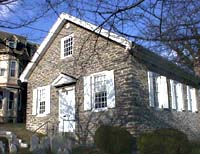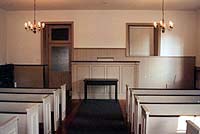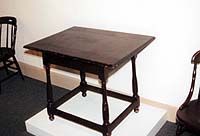Germantown Mennonite Meetinghouse

The stone meetinghouse that stands today was built in 1770 to replace the smaller log building.
The Mennonites originated in 1525 in Zurich as the third wing of the Reformation. They took their name from Menno Simons, an early leader. Mennonites advocated freedom of conscience and only baptized adults who professed a personal faith. They were vehemently against violence and warfare, a doctrine that resulted in many a Mennonite martyr. They spread their beliefs throughout Europe and then to America.
In 1683 thirteen Mennonite and Quaker families sailed from Krefeld, Germany led by Francis Daniel Pastorius, and landed in Pennsylvania. The first permanent settlement of Mennonites in the new world was in Germantown. Later Mennonites moved westward to Lancaster, York, Harrisburg, and beyond. But Germantown was their first home.

Interior of the Meetinghouse.
First Quakers and Mennonites held meeting together in their homes. By 1690, however, the two groups split due to a conflict of interests. The Mennonites wanted a minister, and the Quakers did not. William Rittenhouse, known as the first paper maker in the colonies, was the first Mennonite minister in America. In 1708 the Mennonites built "a little log church," their first meetinghouse in America. Here meetings were held and school was taught by Minister Christopher Dock.
During the Battle of Germantown in 1777, a party of citizens fired on the British troops as they marched up the Avenue, and mortally wounded British Brigadier General Agnew.

The first protest against slavery in America was signed on this desk in Thones Kunders's house. The desk is now on display in the Meetinhouse.
In 1770 the original log meetinghouse was replaced by the fieldstone structure that stands today. In 1908 a Sunday School room was added to the building. In 1968 the Meetinghous was placed on the National Register of Historic Places.
Inside the Meetinghouse visitors can see the desk, upon which the first protest against slavery was signed in the house of Thones Kunders. In the burying ground out front can be found stones of some of Philadelphia's oldest families: Nice, Rittenhouse, Kulp.
1. Photos by Greg Heller, Copyright © 2000 by the Independence Hall Association
2. Marion, John Francis. Bicentenial City: Walking Tours of Historic Philadelphia. Princeton: The Pyne Press, 1974.
3. Jenkins, Charles F. The Guide Book to Historic Germantown. Germantown Historical Society, 1973.
4. "Germantown Mennonite Meetinghouse." Germantown Mennonite Historic Trust brochure.


